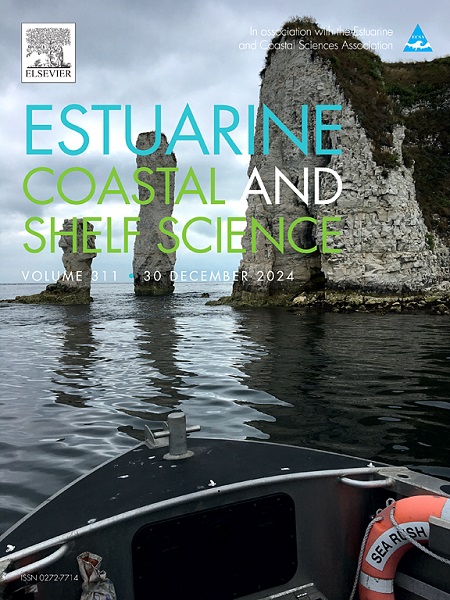将不确定性纳入湿地土壤增积模型(NUMAN 2.0),以测试南佛罗里达沿海环境设置的普遍性
IF 2.6
3区 地球科学
Q1 MARINE & FRESHWATER BIOLOGY
引用次数: 0
摘要
了解地上和地下过程对土壤增积和碳密度的相对贡献,可以解释不同沿海环境下红树林的碳固存率。本文通过改进算法和不确定性分析,利用文献值和特定地点的观测数据,重新制定了营养红树林模型(NUMAN),以评估3个土壤肥力梯度明显的红树林站点的有机和无机沉积的相对贡献,这些站点包括南佛罗里达州的鲨鱼河(N:P = 28)、Rookery Bay (N:P = 54-78)和Taylor Slough (N:P = 102)。NUMAN 2.0将纤维素视为一种难降解的有机物子库,同时将粗根输入纳入土壤形成。模型模拟还捕获了根坏死块的积累。蒙特卡罗(MC)模拟(每个站点N = 1000)通过将五个关键参数作为随机变量来捕获不确定性:细根、粗根和大根中的木质素含量;无机泥沙负荷;以及地表的根生物量。凭借强大的有机物质质量平衡,NUMAN 2.0可以精确预测地表吸积和碳密度。NUMAN 2.0模拟估计,与野外值123.0、86.0和108.8 (8.7)gm−2yr−1相比,鲨鱼河的土壤碳固存率平均(标准差)为130.1(55.4),鸦巢湾为72.5(3.7),泰勒斯劳为130.0 (83.9)gm−2yr−1。基于NUMAN 2.0的模拟实验表明,在外来输入较少的沿海环境(如碳酸盐环境)中,地下有机质通常主导土壤形成和碳固存,而在河口和海湾,树木凋落物则主导土壤有机质。本文章由计算机程序翻译,如有差异,请以英文原文为准。
Incorporating uncertainty in a wetland soil accretion model (NUMAN 2.0) to test generality across coastal environmental settings of south Florida
Understanding the relative contributions of aboveground and belowground processes to soil accretion and carbon density may explain carbon sequestration rates in mangroves across different coastal environmental settings. We reformulated the nutrient mangrove model (NUMAN) by improving algorithms and uncertainty analysis using literature values and site-specific observations to evaluate the relative contributions of organic and inorganic sedimentation for three mangrove sites with marked soil fertility gradients reflected by nitrogen-to-phosphorus (N:P) ratios including Shark River (N:P = 28), Rookery Bay (N:P = 54–78), and Taylor Slough (N:P = 102) in south Florida. NUMAN 2.0 considers cellulose as a refractory organic-matter sub-pool and simultaneously incorporates coarse-root inputs to soil formation. The model simulation also captures root necromass accumulation. Monte Carlo (MC) simulations (N = 1000 per site) were conducted to capture uncertainty by treating five key parameters as random variables: lignin content in fine, coarse, and large roots; inorganic sediment loading; and root biomass at the surface. With robust mass balancing of organic matter, NUMAN 2.0 generates precise predictions of surface accretion and carbon density. NUMAN 2.0 simulations estimated mean (standard deviation) soil carbon sequestration rates at 130.1 (55.4) for Shark River, 72.5 (3.7) for Rookery Bay, and 130.0 (83.9) for Taylor Slough, compared to field values of 123.0, 86.0, and 108.8 (8.7) , respectively. Simulation experiments with NUMAN 2.0 suggest that belowground organic matter dominates soil formation and carbon sequestration generally in coastal environmental settings with little allochthonous input such as carbonate settings, while wood litterfall should dominate soil organic matter in top 10 cm in estuaries, and bays.
求助全文
通过发布文献求助,成功后即可免费获取论文全文。
去求助
来源期刊
CiteScore
5.60
自引率
7.10%
发文量
374
审稿时长
9 months
期刊介绍:
Estuarine, Coastal and Shelf Science is an international multidisciplinary journal devoted to the analysis of saline water phenomena ranging from the outer edge of the continental shelf to the upper limits of the tidal zone. The journal provides a unique forum, unifying the multidisciplinary approaches to the study of the oceanography of estuaries, coastal zones, and continental shelf seas. It features original research papers, review papers and short communications treating such disciplines as zoology, botany, geology, sedimentology, physical oceanography.

 求助内容:
求助内容: 应助结果提醒方式:
应助结果提醒方式:


